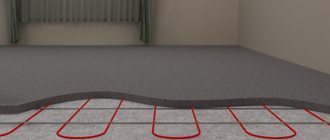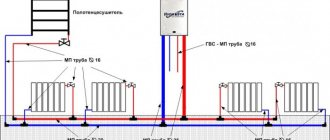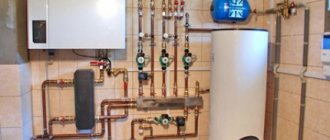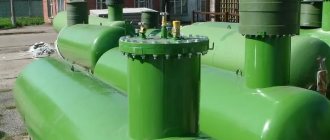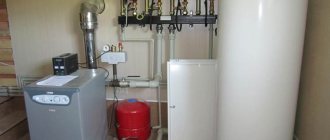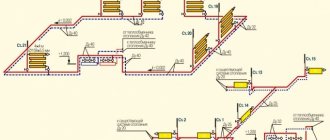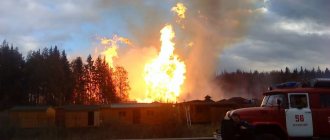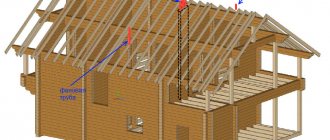Electric heating system
It is believed that electric heating of a private home is the most environmentally friendly method.
But electric heating is a very expensive option. The use of such a system will subsequently be expensive, regardless of what you install for yourself - a heated floor system or an electric boiler, or limit yourself to convectors. When using electricity, you will need to carefully insulate the house, otherwise the street will be heated. But electric heating of a private home can be made fully automated, and its operation will bring a lot of pleasure, in addition to ease of use.
The most popular today are infrared heaters. They consume less electricity and are extremely simple to operate. They do not heat the air in the room, as with a traditional heating system, but all solid objects falling within the radiation radius.
If you have a brick oven
Masonry structures are characterized by high heat capacity and inertia; it takes at least half an hour to sufficiently heat the walls of brick ovens.
This is not considered a disadvantage, since after combustion ends, brick walls retain heat longer and slowly release it to the house. But you shouldn’t hope for quick heating of rooms in houses with such stoves. In the first half hour after ignition, they are heated intensively - with the maximum permissible draft and inflow; after heating the walls and air in the room, the combustion parameters should be stable.
In practice, this means adding equal portions of firewood to the brick stove at intervals of at least 40 minutes, draft control (ideally, automatically, using a regulator), and rare and brief (no more than 15-20 seconds) opening of the combustion door.
The rest of the service rules are standard:
• Before each ignition, the brick stove is cleaned of ash, with special care when using other types of fuel besides firewood.
• 2-3 times a year her chimney is cleaned of soot. Preventive measures and more frequent procedures are allowed, reduction is not, every 1 mm of soot deposits reduces the efficiency of the furnace by 20%.
• At least once a year, all brick oven structures and surfaces are carefully inspected and, if necessary, repaired. Particular attention is paid to the masonry (gaps are unacceptable) and the area near the firebox door (cold air enters the firebox through possible gaps, which in turn leads to excessive consumption of firewood).
Important: Due to the absence of any recommendations from manufacturers, the amount of firewood placed in a brick oven is selected experimentally. The daily consumption rate is calculated taking into account the limitation in the frequency of kindling (no more than 3 times a day) and the duration of each fire within 2 hours.
Choosing the type of heating
According to the principle of operation, heating is:
- Fire-air (“Ammosovskaya” furnace or duct heater. The principle of operation is based on the passage of the combustion product of solid fuel through a system of channels made of cast iron pipes.)
- Steam (The coolant is steam heated in a steam boiler or turbine. Currently prohibited for installation in residential premises)
- Water (Pipeline system for transferring heat from heated water or its analogue, for example, antifreeze)
- Air (The system is based on air heating with air heaters or heat generators)
- Infrared (based on infrared emitters)
- Dynamic (the system is based on the operating principle of a refrigerator and receives heat from a pipeline system located, for example, in the ground. Requires large initial investments and a large area for installation outside buildings)
Water and air are economical and traditional systems for installation in a wooden house. But the greatest preference is given to water ones. Water systems are divided according to the type of energy carrier of the power unit (boiler) into:
- Electrical
- Gas
- Solid fuel
- Combined
Please note - design and installation of heating systems
Methods of heating a wooden house
Approximate diagram of water heating in a wooden house
In wooden houses you can use all known heating systems, from Russian stoves to modern infrared emitters. But when installing some heating devices in a wooden house, it is necessary to take into account a number of nuances. Wood has very low thermal conductivity and high thermal insulation properties. That is, it heats up for a long time and maintains the temperature inside the house well, regardless of the outside temperature. That is why it is warm inside wooden houses and remains cool in the summer. And well-chosen heating devices should make maximum use of the physical properties of wood as a building material.
The efficiency of heating a wooden house largely depends on its area and number of floors. For a small country house, a stove and one stack of firewood is quite enough. A two-story residential mansion should be equipped with a more solid system. The most widespread is water heating with pipe distribution throughout all rooms and a radiator system. Water heating can operate from various sources: solid fuel, gas, electricity. The choice of source of thermal energy affects the choice of boiler, while the piping itself is practically independent of the method of heating it. You can see an approximate diagram of water heating in a wooden house in the figure.
Features of heating systems
The most common heating in Russia is using gas, since it is quite cheap. In addition, the installation of a gas-powered heater is quite simple; you can install it yourself.
That is why quite a lot of people choose the type of heating using gas (cheaper than heating with electricity and convectors).
To install a heater, you need to properly design your house. You should also have a diagram for installing the heater at hand to make installation more convenient.
In addition, you need to mark the location of the gas pipes on the house design. If they are not there, you will have to install a gas pipeline or buy a gas cylinder.
Video:
Water heating is one of the most popular. The principle of its operation is that the water in the boiler is heated and then flows through the pipes, filling the house with heat. The same principle applies to apartment buildings.
In addition to the pipes, water enters the radiators, and from there it returns back to the boiler and is heated again. This type of heating is often supplemented with convectors (wall-floor heater), especially where a single-pipe circulation system is installed.
Water can circulate through pipes naturally or artificially, using additional pressure.
To move water naturally, a single-pipe system is used; for an artificial method, a two-pipe system is used.
It should be remembered that in a single-pipe system it will most likely not be possible to maintain the temperature at the same level, since distant radiators will receive water at a lower temperature for heating.
Therefore, a single-pipe system is better suited for small rooms; it is not recommended to install it in a large house.
The most obvious disadvantage of a single-pipe system is insufficient heating of the lower radiators, which will lead to the fact that different floors of the same house will be heated to different temperatures.
In addition, this option will be optimal only if the boiler is located below the level of the radiators, because otherwise there will not be enough pressure to circulate water.
It should be noted that this option is quite economical, since it does not require a large amount of materials.
As for the temperature, it can be leveled by correctly setting the radiators or choosing those heaters that have a larger number of sections. In addition, radiators can be placed in places where the temperature is lowest.
A diagram of the house will help you understand how many radiator sections will be needed to heat a room of a given size, and where it is best to place the radiators.
Installation of a two-pipe system requires the installation of an additional water tank. You will also need a pump to be able to install the boiler in any room.
It is better to take boilers with a pump included. To better understand which types of heaters are best suited, you can ask a specialist.
Installation of a "warm floor" system
We use heating mats
Stage 1: it is most convenient to use electric heating mats, although they will cost 20-25% more than cable. A groove is made in the wall and floor where the cable in a corrugated tube will go, connecting the heating mats to the energy source, and the temperature sensor. Then all debris and dust are removed from the floor surface. Heating mats can be placed directly on old tiles. The mat mesh is easy to cut, and if the mat is rotated, a cut can be made, but the heating cable must not be touched.
Stage 2: the mat is attached to the floor using a heat gun or tape. Sometimes an adhesive layer on the mesh is already applied to the surface of the mat, and the mat itself sticks well.
Stage 3: a layer of tile adhesive is applied on top of the mat. You need to let it dry completely for 5-7 days.
Stage 4: all connections must be made and the thermostat connected. The functionality and serviceability of the heating system is checked.
Stage 5: You can lay the floor covering on the completely dried adhesive base.
We use a cable
main source of heating
Stage 1: the floor is cleared of old tiles or other material before laying the heat insulator. All debris is swept out and dust is removed.
Stage 2: sheets of heat insulation are laid out on the cleaned surface. The joints between the sheets are taped.
Stage 3: a reinforcing mesh is laid on top of the thermal insulator and an intermediate screed no thicker than 3 cm is poured. Wait 3-5 days until it dries completely.
Stage 4: after the screed has completely dried, mounting tape is applied to it.
Stage 5: a detailed cable laying diagram is drawn up. You need to start laying from the bridge connecting the wiring to the thermostat. It is necessary to take into account the cable manufacturer's recommendations regarding the minimum bending radius of the cable and the minimum distance between the cable threads. Do not run the cable under areas where plumbing fixtures and furniture will subsequently be installed.
Stage 6: the thermostat is installed inside the corrugated tube. All components of the electrical system are connected.
Stage 7: after checking the operation of the heating system, a second screed 3-10 cm high is laid. You must wait a month until it dries completely.
Stage 8: Now you can lay any flooring.
How to properly heat a wood stove in a wooden house
How to properly heat a stove with wood in a wooden house, as efficiently as possible, and so that the stove doesn’t crack and you don’t get burned? General procedure Lighting up wood-burning stoves begins with checking them and cleaning them from ash and soot. This stage is general and mandatory, regardless of the design and volume of the firebox; without air access, the firewood simply will not burn. After that:
1. Paper and thin dry wood chips are placed on the cleaned grate, ignited with the combustion door or its damper open and the view and ash pan closed.
2. After ignition, thick logs are laid on top of the burning splinters in even horizontal rows or a pyramid, filling from 1/3 to 2/3 of the volume of the firebox. The fire door closes, the view and the ash pan, on the contrary, open completely and remain in this state until the firebox is completely warmed up and an even golden flame appears.
3. When the firewood is completely ignited (all the logs are engulfed in flames, the flame turns from blue to yellow, the stove hums steadily), the combustion process is prolonged as much as possible, the draft is regulated using the lower dampers. If the draft is too strong, the blower closes with a gap of 1-2 cm or completely.
Further actions depend on the planned number of bookmarks, wall parameters and the initial temperature in the house.
Very cold and rarely visited wooden log houses are heated with at least 3 loads of firewood; with daily heating in the stove, only one large portion of firewood can burn out.
Accordingly, if additional refilling is necessary, the condition of the logs is monitored, the second portion is placed on burnt but not cooled coals collected towards the middle of the grate.
ATTENTION! A brick stove can be easily overheated and it will crack, so approach this responsibly and follow the recommendations. Under no circumstances should your oven become too hot to touch. And it is important to understand that the stove does not warm up immediately, so make small piles of firewood evenly.
Advantages and disadvantages
Heaters have become very popular lately. If there is no gas on your site, then you can heat your home using this method. The main advantages of electric heating of a wooden house include:
If you position all the heaters correctly, then the heating effect will be several times higher than with stove heating.
- This type of heating involves no emissions into the atmosphere.
- You can install the heaters yourself.
- Thanks to electronic thermostats, you can easily regulate the heat in your home.
- If you choose the right manufacturers, then repairs will rarely be necessary.
- You no longer need to stock up on firewood or coal.
- Each type of electric heater for a wooden house is compact.
- Electric heating can be used as main or additional.
In addition to the advantages, heating in a wooden house can also have disadvantages, which include:
- Today, the power grid can often be shut down for repairs. If there is no light, then there will be no heat.
- You will need to purchase a diesel generator. In the event of a power outage, your system will operate reliably.
- You will need to change the meter to a two-tariff one.
- Electric heaters are considered fire hazardous devices. In order to protect your home, you must take into account all the recommendations.
If you don’t know which electric heating to choose for a wooden house, then watch the video.
Implementation options
How can you implement gas heating of a wooden house with your own hands?
Actually, there are two options.
A gas boiler
A centralized boiler (see how to choose a gas heating boiler) heats the coolant by burning gas. It circulates through the pipes, giving off heat to radiators located under the windows, which have a completely safe temperature (not higher than 80C). They, in turn, warm the air in the rooms.
The layout will look something like this.
This solution is optimal if you have mains gas. In this case, it will only be supplied to a well-ventilated boiler room, which is clearly safer than distributing gas throughout the house.
Are there any nuances that are useful to know when designing?
- Willy-nilly, you will have to prefer a gas boiler for heating a convection-type private house. More economical condensing systems require a very low return pipe temperature, which is difficult to achieve while maintaining heat in the house when using radiators. And a warm floor with its lower water temperature, as we remember, is difficult to install in a wooden house.
- The optimal design of the heating system, resulting from the type of boiler (a convection boiler uses a return temperature of at least 60C), is single-pipe, barracks type. A thick (at least 1 1/4 inch) pipe encircles the perimeter of the house; The radiators do not tear it apart, but cut in parallel. This is exactly what is shown in the diagram above.
- Boilers with electronic ignition are more economical. The fact that they do not require a constant flame from a pilot burner also means they are somewhat safer. If you have frequent power outages, just purchase an uninterruptible power supply.
The circulation pump is also perfectly powered from the same UPS. True, then it is better to worry about buying additional batteries.
Important: for normal operation of electronic ignition, not only zero and phase wiring is required, but also grounding.
Gas convector
If you only have imported gas in cylinders, gas convectors will be a very convenient solution. They do not require coolant distribution throughout the house: the convector is mounted directly under the window, and the cylinder is placed in this or an adjacent room.
The air intake comes from the street, and combustion products are discharged there through a coaxial pipe.
The only nuance associated with this type of heaters is that they will provide heating only for the room in which they are located. If there are many separate rooms in the house, a convector will have to be installed in each. Accordingly, the number of cylinders that will have to be transported to the gas station will increase.
The convector in the photo, however, perfectly heats the halls on the first and second floors. If the rooms are not insulated, the possibility of heating is limited only by its thermal power.
The main advantage of gas convectors compared to a boiler with room-by-room distribution is the price of the project. One convector is not much more expensive than a high-quality bimetallic radiator. Moreover, it does not need a boiler or pipes.
How to heat a house
People live in an individual house all year round, so it is possible to use water systems - radiator and floor heating. Often a fireplace is used as an additional heat source. Electric heating is very convenient and does not require constant supervision, but it is expensive.
The best option for do-it-yourself heating in a private house is to install a “warm floor”. A radiator heating system is easy to install, but it is less economical.
In addition, in middle and northern latitudes, when modernizing an old, uninsulated house, a “warm floor” may not provide sufficient heating of the house, and additional heating sources will have to be used, including the installation of radiators. The electrical system is directly dependent on uninterrupted power supply.
Stove heating
Solid fuel stoves with a pipe system are a popular type of heating
The historically established method of heating a wooden house is heating using a solid fuel stove or boiler. The most famous option is the classic Russian stove. True, such a stove is not always suitable for fully heating a large two or three-story mansion. More often it is used to heat a small house or to give a special touch to the interior.
It is more practical to heat a wooden house with a solid fuel boiler. The system heats the house using hot coolant, which moves from the boiler through pipes and radiators. The larger the radiator surface, the more heat the room receives. Such boilers can operate on different types of fuel: wood, coal, pellets. A small automation of the process is possible only in the most modern models, but in a very limited range: since it is impossible to turn such boilers on and off automatically.
Choosing the best type of heating for your wooden house is not an easy task. It is necessary to provide not only financial costs, technical difficulties of installation and the capabilities of conducting networks, but also many other factors:
- how harmful a heating system is to the environment;
- what impact will the people permanently residing in the house be exposed to;
- what are the possibilities of combining different heating methods, etc.
Taking into account all of the above, you can compare different methods of heating your home and make a choice based on an accurate calculation. And design specialists will help you create an accurate and verified project that will help you avoid mistakes in installing life support systems at home
You can clearly see the methods of heating in a wooden house in the video.
https://youtube.com/watch?v=KlvyaXQerTo
Heating boiler diagram
Water heating in a wooden house cannot be imagined without a boiler that provides heating of the coolant. The boiler is a device operating in automatic mode. There are several types of equipment that use different types of fuel.
Heating boiler diagram
The heating system in a wooden house can be installed using the following types of boilers:
- gas;
- electrical;
- diesel;
- working on solid fuel.
It is worth considering separately the features and types of infrared heating. This model of heating system uses electricity to operate, and at the same time has economical consumption compared to electric boilers. The disadvantage of this option is the inability to heat large rooms; often infrared equipment plays a supporting role.
Features of installation of water heating
The radiator system and floor heating using warm water pipes have their own technological features that determine the possibility of their use in an individual home.
Floor heating is 15-20% more economical than using batteries. But floor heating is not always possible for technical reasons.
Water floor heating is not installed above living spaces - on the second floor or in the attic. Laying insulation, pipes and screeds requires an additional 120 mm of room height and a more powerful ceiling under the floor, so it is necessary to provide a “warm floor” system at the stage of designing a house.
When modernizing an already completed building, it may turn out that the ceiling is not strong enough for a warm floor, you need to raise the doors and the windows will be too low. Therefore, in an old house, it is more rational to do the heating yourself using radiators.
Stages of heating installation in a wooden house
It is more logical to install some types of heating during the construction of a house
Whatever type of heating you choose, it is advisable to do this at the design and construction stage. Some types of heating systems require the presence of structural elements, which are quite difficult to create after construction is completed. For example, local foundations of furnaces or the presence of in-wall air ducts. Some necessary conditions for installing a particular heating system can only be met during the construction stage. Of course, in a finished wooden house you can install almost any heating system from scratch, but often installing heating without a preliminary design leads to additional repair work, remodeling, and, consequently, new expenses.
In addition, any heating scheme that you want to implement in a wooden house requires careful calculation of heat loss. An incorrect calculation can lead to excessive consumption of a large amount of fuel, large heat leaks to the outside and an uncomfortable living temperature. To avoid these troubles, the structure must be carefully insulated and insulated. Insulation is done both superficially (external walls, ceilings, roof) and butt (joints of structural elements of the house).
Also, we must not forget about ventilation. The flow of fresh air is necessary not only for the functioning of heating systems, but also for a comfortable existence inside the house. Especially when arranging such heating for a wooden house, when an open fire is used (stoves, fireplaces)
When using an open fire for heating, special attention must be paid to safety precautions. Firstly, the installation site of the stove or fireplace must be equipped in compliance with fire safety standards
Secondly, the wooden elements of the house must be treated with special fire retardant compounds. Careful compliance with these requirements will protect you and your home from possible troubles.
So, what options for heating a wooden house exist? Let's take a closer look.
Solid fuel boiler: a practical solution
Firewood is the most affordable energy source today. And most importantly, it allows you to get economical heat. By installing a boiler that runs on wood, coal, briquettes or coke, the homeowner receives a heating system with high energy efficiency and quick payback due to low operating costs.
Among the disadvantages of this option, it is worth noting the need for constant human participation in the operation of the equipment. A boiler room for a solid fuel boiler must meet a number of strict conditions - the risk of fire if such an installation is not properly operated is very high. Especially in a wooden house.
Read more about solid fuel boilers in our article:.
Aluminum heating radiators
Aluminum radiators appeared on the market relatively recently and have become popular due to their appearance. However, in addition to their beautiful appearance, they have a lot of limitations, mainly related to their characteristics. Don't install them without thinking.
Aluminum radiators have high power and quickly heat up the room, spending much less coolant than, for example, cast iron ones. Like steel, aluminum radiators fit perfectly into any interior.
Due to its chemical properties, aluminum is resistant to alkaline environments. Therefore, when installing aluminum radiators in your home, be prepared for the fact that you will have to constantly monitor the quality and pH of the coolant. The pH should be from 7 to 8, and even drinking water does not always have such indicators.
There are other nuances when installing aluminum radiators, so it is better to entrust their installation to professionals.
Stove heating
One of the oldest heating options, but not the latest in consumer choice. The stove does not require special costs for the raw materials used, and it is also quite heat-intensive, which allows you to keep the house warm for a long time, as well as cook food on it. Like all methods, it has its own special points: such a heating system is only suitable for those houses with no more than two floors, excluding the basement. In addition, regular cleaning of the chimney and stove structure will be required to avoid the risk of fire or carbon monoxide poisoning. Also, the oven temperature should not exceed 120 degrees.
As we can see, heating a wooden house is a very important and troublesome task, but by choosing the best option for yourself, you will feel warm and cozy in any weather. Escaping from 4 stone walls and the bustle of the city is the dream of many people
Isolate yourself with nature in your home - what could be better? A wooden house has such advantages as environmental friendliness, low cost, and speed of assembly. But having taken this step, sooner or later you will be faced with the task of heating in a wooden house. This should be approached very carefully. It is usually colder away from the urban agglomeration, so you need to prepare in advance for the coldest temperatures. And it’s better to do this in the warm season of the year. Heating a wooden house involves the following options: gas, electric, air, water
Breaking away from 4 stone walls and the bustle of the city is the dream of many people. Isolate yourself with nature in your home - what could be better? A wooden house has such advantages as environmental friendliness, low cost, and speed of assembly. But having taken this step, sooner or later you will be faced with the task of heating in a wooden house. This should be approached very carefully. It is usually colder away from the urban agglomeration, so you need to prepare in advance for the coldest temperatures. And it’s better to do this in the warm season of the year. Heating a wooden house involves the following options: gas, electric, air, water.
Often there is no classical gas heating in a wooden house, and installing it yourself is very problematic. Therefore, all options should be considered.
Heating a wooden house
Installation of a heating system in a log house. Wooden houses have one distinctive feature compared to houses made of stone materials - the walls of a wooden house allow you to control the level of humidity inside the house, which is why you can notice that it is warm and dry in winter, and cool in summer, and all this happens thanks to wood. But in the modern world, it is impossible to manage without heating a home, and therefore it is very important to correctly calculate the heating system and the location of heating radiators. Otherwise, we may experience uneven shrinkage of the house due to an imbalance in moisture consumption and moisture loss of log walls during many periods of changing seasons. The consequence may be deformation of the logs and a violation of the thermal insulation characteristics of the wooden house.
Features of installation of the heating system.
— it is important to consider that the direct direction of heat flow from the heating source is to the center of the room and to the floor, and in no case to the walls and ceiling; — due to the gradual shrinkage of the walls of the house, when installing heating radiators, it is necessary to take into account compensators so that there is no forced deformation of the heating main; — the power cable (if the entire system is connected to a power source) must be of sufficient diameter and withstand the electrical load.
Let's look at what types of heating there are for wooden houses, which have their own advantages and disadvantages:
ELECTRIC HEATING.
It is perhaps the most common type of heating of wooden houses and cottages.
For a number of reasons, not every site has a gas main. The advantages of electric heating include: environmental friendliness; ease of installation and virtually no maintenance of the heating system, since many systems already have automatic settings due to the use of electronic thermostats; aesthetic and compact appearance of electric heaters, quiet operation. The disadvantages include: quite a large consumption of electricity, and given the fact that local electricity supply network companies allocate a small amount of electricity, there will be additional considerable costs for the allocation of additional kilowatts of electricity; in case of a power outage - the presence of a diesel generator or portable mini power station; Infrared heaters are quite fire hazardous; their installation requires strict requirements. Figure 1. Electric heating boiler.
Figure 2. Heating system based on cross-linked polyethylene (expansion tank, two combs, cross-linked polyethylene pipes).
Figure 3. Collecting combs.
Figure 4. Type of heating connection - radiant.
Figure 5. Special tool for stitching polyethylene pipes.
Figure 6. Heating pipes made of cross-linked polyethylene. Water supply pipes.
Types of heating pipe routing. Two-pipe contour and radiant heating systems.
Figure 7. Two-pipe loop heating system.
Two-pipe loop system
. (Fig. 7; Fig. 11). It is a universal type of connecting heating radiators. The movement of water is carried out along a contour: the incoming and outgoing lines run parallel to each other. The installation of a two-pipe system requires less material compared to a radial connection system, but on the other hand there is a risk of uneven heat transfer (in other words, there will be a temperature difference in the first radiator and the last) to heat the room due to differences in water pressure and in the case of For repairs in some heating area, you will have to turn off the entire system.
Two-pipe radiant heating system.
Compared to a loop system, it is more energy efficient - each radiator (heating element) receives a uniformly heated volume of heat-carrying fluid. The ability to carry out repairs without shutting down the entire heating system. The only drawback is the increased consumption of materials.
Figure 8. Design of a radiant heating system.
Figure 9. Radial system for connecting heating pipes.
Methods of heating a wooden house.
Heating radiators
– the device diagram is based on an internal closed hot water supply system through a boiler. The choice of boiler is determined by the characteristics of each wooden house as a whole and the cost of the equipment.
Figure 10. Heating in the floor. Built-in heating radiator.
Figure 11. Location of heating radiators in the bay window. Two-pipe heating system.
Infrared heaters. IR film
– some difference from other heaters is the direction of the flow of warm air from top to bottom. Cost-effective, no main pipes.
Figure 12. Ceiling IR heater.
Figure 13. Option for heating a room with IR film.
Figure 14. Warm floor under tiles.
DIESEL HEATING.
The efficiency of such heating is about 95% (for comparison, stove heating is about 65-75%). It is much less of a threat compared to gas heating; you just need to ensure proper storage of the fuel. Modern diesel boilers allow you to burn fuel completely, reducing the emission of harmful substances to zero, but unfortunately you should not forget about the disadvantages: firstly, there is a constant smell of burning fuel, so when designing a house, take into account the location of the diesel boiler as far as possible from the living rooms. Secondly, this is the cost of fuel, taking into account the Russian specifics regarding pricing of burned fuels - the price has only an upward trend. By the way, the quality of diesel fuel should be quite good, despite the filters in the diesel boiler.
Figure 15. Single-circuit gas boiler.
GAS HEATING.
This type of heating is the most economical compared to other heating options, ideal for large wooden houses and permanent residences. The only disadvantages are fire safety, because gas is an explosive and flammable gas, and therefore great demands are placed on the installation of gas equipment. And the second disadvantage is the cost of connecting to the main gas pipeline, but over time this pays off, since the cost of gas is many times cheaper than liquefied gas and electricity. An additional option is to purchase your own gas tank. Refilling is approximately once a year, the cost of gas is approximately three times more expensive than main gas.
There are two types of gas boilers: single-circuit
and
double-circuit
. Each type has its own characteristics and further we will consider them separately.
Single-circuit gas boiler.
Performs only one function - heating the house, that is, the inability to produce hot water. The advantages are small size, closed combustion chamber, light weight, electronic ignition.
Double-circuit gas boiler.
They are the most popular because, compared to single-circuit boilers, they perform two functions - both heating the house and heating water to a given temperature, as well as maintaining it. The advantages are noiselessness, economical gas consumption due to the use of modern heat exchange systems, and ease of installation. The gas boiler kit includes an expansion tank, a security system, a pump and an electronic control unit (ECU).
Figure 16. Double-circuit gas boiler.
Figure 17. Wall-mounted, double-circuit floor-mounted gas boiler. Expansion tank (red color)
Requirements for the location of the gas boiler.
The area of the room must be at least 4 square meters, if other heating equipment is located, then at least 8 square meters; presence of supply and exhaust ventilation; the need to install a large window and door in case of ventilation; covering walls with non-combustible materials; availability of indoor water supply. If a wooden house has an area of less than 100 square meters, wall-mounted gas boilers should be installed - where every square meter counts.
GEOTHERMAL HEATING.
(All information and pictures of the heat pump are taken from the site
https://www.pea.ru/docs/
). Refer to alternative energy sources. Over the past few decades, this type of heating has already gained popularity in developed countries, including Russia. The circuit is a heat pump operating according to the Carnot principle, that is, according to the principle of a reflux refrigerator. The liquid moves between two objects: a heater - earth or reservoirs and a refrigerator - a wooden house, which have positive temperatures, but differ in its level.
Figure 18. Heat pump operation.
Figure 19. Geothermal probe.
The attractiveness of this scheme is that by spending 2 kW of electricity, we receive from 4 kW to 12 kW of heat. This, of course, contradicts the law of conservation of energy, but in this case we do not produce such heat, but transfer it from the “ground” to the house. The efficiency of such an installation is about 250-300%. In other words, we can endlessly use the heat under our feet with little electricity costs, depending on the type of equipment.
The heat pump is a closed system consisting of a geothermal probe
(Fig.19),
evaporator (evaporation process)
,
compressor (compression process)
,
condenser (condensation process)
and
throttle (expansion process)
. The heat pump system uses a refrigerant - freon, which has a boiling point of 4°C. When freon is heated above its boiling point, it begins to boil and goes into a gaseous state (evaporation). Next, the freon enters the compressor under pressure, where it is compressed and releases heat (the freon temperature, depending on the amount of compression, reaches 80°C and above). Then the freon gas enters the condenser, where it is cooled by transferring heat to the heating system. Due to a decrease in temperature and pressure in the throttle, freon passes into a liquid state, and then the cycle repeats. The entire operation of the heat pump is controlled by a thermostat.
Figure 20. Heat pump diagram.
Figure 21. Comparison of prices for types of heating.
It is important to note that the cost of heating a room with a heat pump is several times less than other types of sources. Let’s give a small example: with a house area of about 120 square meters, the cost of 1 kWh of heat produced by a heat pump compared to natural gas is 3 .5 times less, electricity – 4.5 times less, diesel – 7.5 times less.
Considering this comparison of costs, we can assume that it is better to install a heat pump with all the necessary equipment once and not think about huge heating costs, which is very important for wooden houses with a large area.
Ventilation system installation
Replacing the battery
The device is equipped with a lithium battery ER14250 or CR2032. Possible replacement options are given in the user manual.
To replace you will need:
- Remove the terminal compartment cover secured with screws on the front side.
- Dismantle the electronic unit in the same way.
- Remove the used element by soldering a new one.
- Reassemble the device in reverse order.
After completing the work, the organization that changed the battery indicates this fact in the corresponding section of the meter passport.
